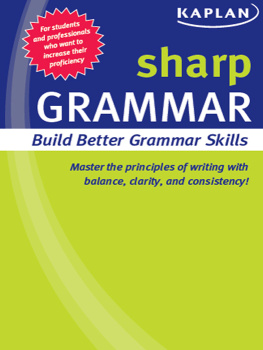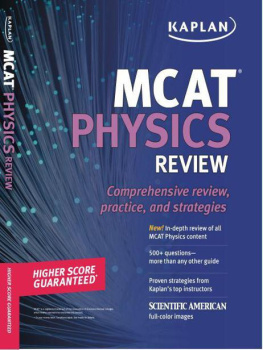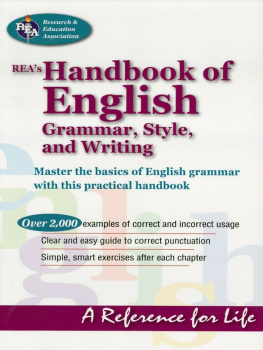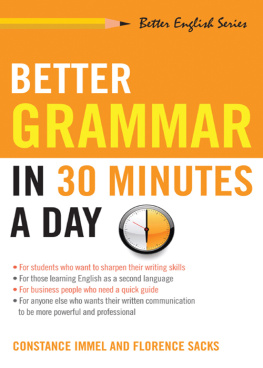Related Titles Sharp Math Sharp vocab Sharp writing  sharp
sharp
GRAMMARBuilding Better Grammar Skills Contents Dear Reader, Is your writing plagued by runaway commas? Do you find you use fifteen words for a point you could have made in three? Whatever the reason, you picked up this book, which means you want to improve your grammara smart decision. Why? Because knowing andusing good grammar will get you places. Good grammar can improve your test scores, get you hired or promotedor simply give you more confidence when interacting with other people. The problem is, most people have found improving their grammar a tedious process. But it doesnt have to be. Allow us to introduce the BuildingBlock Method. This teacher-approved method was devised by the experts at Kaplan to make learning as painless as possible.
Contents Dear Reader, Is your writing plagued by runaway commas? Do you find you use fifteen words for a point you could have made in three? Whatever the reason, you picked up this book, which means you want to improve your grammara smart decision. Why? Because knowing andusing good grammar will get you places. Good grammar can improve your test scores, get you hired or promotedor simply give you more confidence when interacting with other people. The problem is, most people have found improving their grammar a tedious process. But it doesnt have to be. Allow us to introduce the BuildingBlock Method. This teacher-approved method was devised by the experts at Kaplan to make learning as painless as possible.
Youll begin with basic grammar principles. Then youll move on to a system for learning and memorization that draws on real-life situations as practice exercisesa convenient way to learn grammar while going about your everyday life. Theres no smarter way to learn. So get startedgood grammar is only a few building blocks away! HOW TO USE THIS BOOK The fifteen chapters in this book are divided into three sections, beginning with fundamentals, so everything else builds upon a firm foundation. Section I: The Building Blocks of Sharper Grammarand Sentence Structure The first nine chapters cover the fundamentals, from the most basic parts of sentences to the rules for sentence boundaries and word order. Section III: The Building Blocks of Sharper Punctuationand Mechanics The final section reviews the rules for punctuation, capitalization, and spelling to make your sentences clear and error-free. Section III: The Building Blocks of Sharper Punctuationand Mechanics The final section reviews the rules for punctuation, capitalization, and spelling to make your sentences clear and error-free.
Whether you read this book from start to finish or only want to brush up on certain topics, you can systematically improve your skills. Each chapter contains five key components: 1. Building Block Quiz Begin each chapter with a short quiz. The first few questions will cover material from earlier lessons; if you get them wrong, go back and review! The next seven questions will test the material to be covered in that chapter. This quiz helps reinforce what youve already learned while targeting the information on which you need to focus in each chapter. 2. 2.
Detailed Lessons Each chapter explains in detail one specific grammar or style concept, with lots of relevant examples and memory aids. Remember, dont start a new chapter if you havent mastered the earlier materialor youll be building on a weak foundation. 3. Plentiful PracticeRepetition is the key to mastery. So be prepared to practice, practice, practice! Youll find everything from simple matching exercises to exercises that ask you to apply the skills youre learning to practical, real-life situations. 4. 4.
Summary Each chapter concludes with a concise review of key points. 5. Chapter Quiz At the end of each chapter, youll take a diagnostic Chapter Quiz, covering material in that chapter and key concepts from previous chapters. The Chapter Quiz will help ensure that you master each chapter before you move on to the next. THREE BASIC PRINCIPLES Many people are intimidated by grammar because there are so many rules to remember. But all of those rules are based on just three underlying principles:
| Balance | Clarity | Consistency |
Subject-verb agreement is about balance.
Pronouns and verb tenses need to be consistent. Correct spelling and punctuation make your meaning clear. Well remind you of these core principles throughout the book. By recalling them, youll find any rule easier to learn and remember. With a system as easy as this, good grammar is well within your reach. All you have to do is take the first step.
Good luck!
BUILDING BLOCK QUIZ Start your study of grammar with this 10-question Building Block Quiz. Read each sentence below and determine the part of speech of the underlined word. 1. Jack and Jill went up the hill to fetch a pail of water . (A) noun (B) pronoun (C) verb (D) interjection (E) preposition 2. (A) conjunction (B) verb (C) adjective (D) adverb (E) pronoun 3. (A) conjunction (B) verb (C) adjective (D) adverb (E) pronoun 3.
Ouch ! he cried. (A) preposition (B) adverb (C) conjunction (D) noun (E) interjection 4. Jill continued up the hill. (A) verb (B) preposition (C) adjective (D) noun (E) pronoun 5. She filled the bucket and headed back to where Jack lay. (A) pronoun (B) interjection (C) noun (D) verb (E) adverb 6.
Jill balanced the bucket on her head as she walked. (A) verb (B) conjunction (C) adjective (D) pronoun (E) preposition 7. I thought we were a team, she said to Jack, but I guess not. (A) conjunction (B) adverb (C) noun (D) interjection (E) verb 8. It seems that every time we come here, you fall, and I have to do all the work. (A) pronoun (B) adjective (C) noun (D) adverb (E) verb 9.
Enough is enough! she said angrily . (A) conjunction (B) adjective (C) adverb (D) preposition (E) interjection 10. And she dumped the entire pail of ice-cold water on Jacks head. (A) noun (B) adjective (C) pronoun (D) conjunction (E) adverb BUILDING BLOCK ANSWERS AND EXPLANATIONS1. A A noun is a person, place, or thing. 2. 2.
B Verbs express action or a state of being. Fell is an action. 3. EOuch! expresses pain. An interjection is a short, usually emotional, word or phrase that can stand alone as a sentence. 4.
B Prepositions express the relationship (often, but not always, in time or space) between two words. Up is a preposition showing the spatial relationship between the verb and the hill. 5. CJack is a person, therefore a noun. 6. Her replaces the noun Jill . 7. 7.
A Conjunctions connect words or parts of sentences. But connects the independent clauses I thought we were a team and I guess not. In the first sentence, and joins Jack and Jill.8. EHave is a verb expressing a state of being. Come is a verb expressing action.9. Angrily modifies the verb said, telling us how Jill spoke. 10. 10.
B Adjectives modify or describe nouns or pronouns. Ice-cold describes the noun water . We begin this book with a thorough review of the parts of speechwhat they are, how they work, and why they matter. Basic? Yes. Essential? You bet. In this and every other chapter, if you aced the Building Block Quiz, congratulationschances are you already know most of the material in the chapter.
Make sure youve mastered the material by taking the chapter 1 Quiz. If that goes just as well, by all means, move on! If not, find the sections in the lesson that cover your weaknesses. Do the practice exercises to sharpen your skills and then head on to the next chapter. FORM AND FUNCTION Words are the building blocks of sentences: we string them together in endless combinations of phrases, clauses, and sentences to express our ideas. Each word serves a particular function within a phrase, clause, or sentence. A word might describe, name, or connect; it might show the relationship between two ideas or express emotion.
Next page













 sharp
sharp Contents Dear Reader, Is your writing plagued by runaway commas? Do you find you use fifteen words for a point you could have made in three? Whatever the reason, you picked up this book, which means you want to improve your grammara smart decision. Why? Because knowing andusing good grammar will get you places. Good grammar can improve your test scores, get you hired or promotedor simply give you more confidence when interacting with other people. The problem is, most people have found improving their grammar a tedious process. But it doesnt have to be. Allow us to introduce the BuildingBlock Method. This teacher-approved method was devised by the experts at Kaplan to make learning as painless as possible.
Contents Dear Reader, Is your writing plagued by runaway commas? Do you find you use fifteen words for a point you could have made in three? Whatever the reason, you picked up this book, which means you want to improve your grammara smart decision. Why? Because knowing andusing good grammar will get you places. Good grammar can improve your test scores, get you hired or promotedor simply give you more confidence when interacting with other people. The problem is, most people have found improving their grammar a tedious process. But it doesnt have to be. Allow us to introduce the BuildingBlock Method. This teacher-approved method was devised by the experts at Kaplan to make learning as painless as possible.